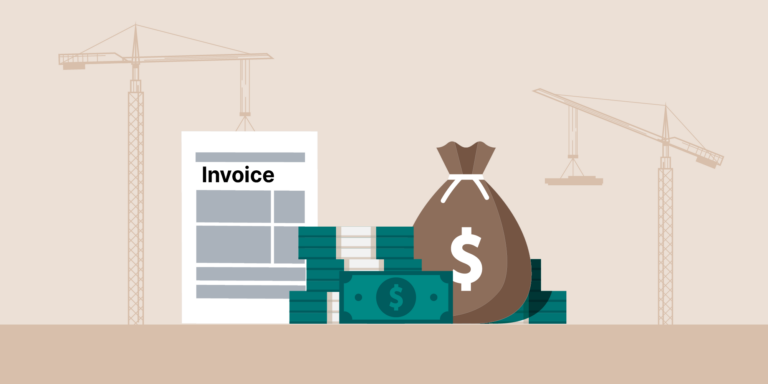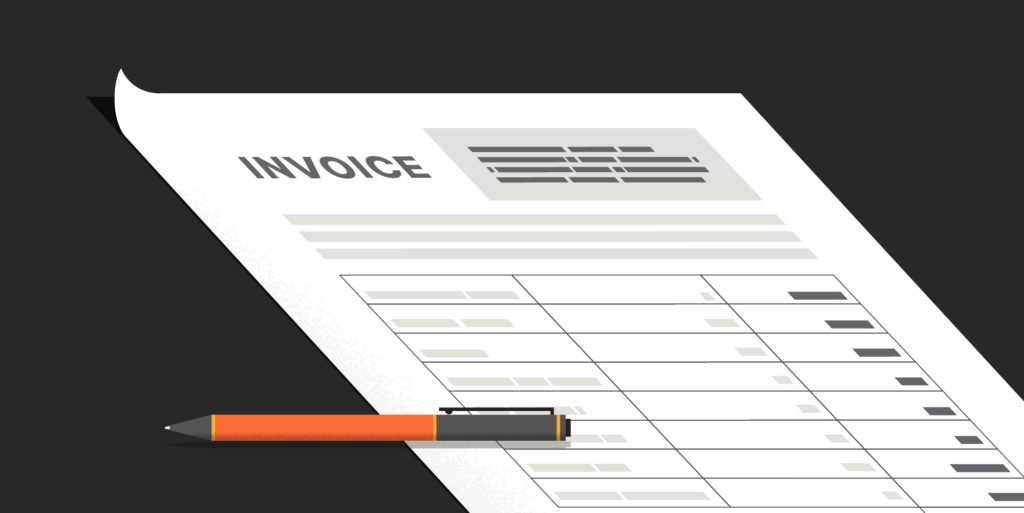— 7 min read
Construction Invoice Factoring: A Quick Guide
Last Updated Apr 21, 2025
Last Updated Apr 21, 2025

Construction companies need to maintain consistent cash flow. Projects can take years to complete, and delays and unforeseen events may keep expenses mounting. Adding to this load are typically high upfront costs, like materials, equipment and labor. One way to stay solvent while waiting for clients to make their final payments is construction invoice factoring.
This guide will explore how invoice factoring works, its advantages and disadvantages and how to get started with the process.
Table of contents
What is invoice factoring?
Factoring invoices or “receivables” involves selling outstanding invoices to a factoring company at a discount. These third parties then take over the management of the invoice, paying out an advance (usually around 70% to 90% of the total amount due) and ultimately facilitating payment from clients. This has the dual advantage of boosting a contractor’s cashflow and cutting down on administrative duties.
Factoring companies profit by charging a fee for their services, along with interest on the unpaid invoices. Contractors who plan to use invoice factoring ahead of starting a new project can build these costs into their quotes so they aren’t losing out.
Invoice factoring is a common tool used to free up resources across a variety of other industries, including manufacturing, healthcare and medical services and more.
How Invoice Factoring Affects Construction
Because of the nature of the construction industry, many contractors wind up shouldering much of the cost of projects — including materials, equipment and labor — before they receive any payments.
Contractors often don’t bill project owners until well after a project has begun, and even then slow payments are common in the industry. Many construction companies use factoring companies regularly to guarantee earlier payments to help maintain healthy cash flow.
While invoice factoring is not a loan, it can offer a similar advantage of making funds available immediately. This may especially benefit smaller companies, who may not have many concurrent or recently completed projects to keep funds coming in.
How does factoring construction receivables work?
Factoring companies have set criteria for the invoices they will accept. Factoring companies may only cover invoices for work that is complete or materials that have already been paid for. However, factoring companies that specialize in the construction industry may also take on invoices for progress payments. Other criteria may include items such as:
Invoice Size
Most factoring companies prefer to deal with large invoices. Smaller invoices may qualify for factoring in some cases, but this is at the company’s discretion.
Payment Terms
The invoice should have a payment term from 15 to 90 days, although terms of 30 to 90 days are generally preferred. Some companies may accept overdue invoices, but these usually incur higher fees, as they are considered riskier.
Client Credit
The client must be deemed creditworthy. This is the most important consideration for the factoring company, as the client is expected to cover the advanced funds. Invoices to private individuals (as opposed to companies—i.e., B2B) or clients with poor or nonexistent credit histories may not qualify.
Legal Complications
Invoices should be free of construction liens, claims or other hindrances and the billed work should not be disputed by the client.*
Once a contractor has submitted qualifying invoices to the factoring company and they have assessed the client’s creditworthiness, they will release a cash advance of approximately 70–90% of the invoice’s total within a few days.
Later, they will collect the payment directly from the relevant clients, then release the outstanding cash, less their own fees and any applicable interest.
* Some factoring companies that specialize in construction may still be able to assist in the case of certain legal complications.
The Key Types of Invoice Factoring
There are two primary types of invoice factoring: recourse and non-recourse.
Recourse factoring means that the contractor retains ultimate responsibility for the client paying the invoice. If the factoring company does not manage to procure payment from the client, the contractor has to buy back the invoice. This shifts the risk from the factoring company to the contractor, so fees may be reduced.
In non-recourse factoring, the factoring company retains the responsibility for invoice payment, bearing the risk of non-payment. This protects the contractor from clients defaulting, but may result in higher factoring fees.
Within these two types, there can be several subtypes or special options. These include:
- Spot Factoring: Selling individual invoices to a factoring company instead of all invoices relating to a project
- Whole-turnover Factoring: Selling all invoices over a specific period to a factoring company
- Progress Billing Factoring: This invoice factoring relates to partial invoices — the “progress payments” that construction companies often bill clients for
Factoring companies that specialize in construction sometimes offer additional services, like handling lien rights and ensuring compliance with the specific payment structures of the industry.
Stay updated on what’s happening in construction.
Subscribe to Blueprint, Procore’s free construction newsletter, to get content from industry experts delivered straight to your inbox.

Advantages & Disadvantages of Construction Invoice Factoring
Advantages of invoice factoring include:
Fast Access to Cash
Unlike the uncertainty of timely payments from clients, invoice factoring guarantees a set percentage of all qualifying invoices up front for easier cash flow management.
Alternative to Traditional Credit
Accessing business loans can be challenging: the approval process can be lengthy and loans can be denied. Even approved loans may be too small to cover expenses. Invoice factoring provides an efficient alternative to traditional lending that won’t reflect as a liability in accounting systems.
Helps Boost New Businesses
Receiving partial payments before completing early projects can offer a head start to new contracting businesses, so they can plan future projects, hire staff or invest in equipment.
Keeps Contractors Competitive
With reliable and regular cashflow, contractors can invest in new equipment, staff or marketing, and take on larger projects with greater ease.
Lowers Financial Risk
Non-recourse invoice factoring puts the risk of non-payment on the factoring company, which can provide peace of mind for contractors.
There are some potential disadvantages to invoice factoring, along with pitfalls to look out for. These include:
Can Create Additional Costs
While a loan may not accrue any interest if paid back within a specific time period, invoice factoring always involves some costs to contractors.
Dependent on Credit
Whether or not an invoice is suitable for factoring depends almost entirely on the creditworthiness of the client.
Could be Perceived Negatively by Clients
There’s no hiding invoice factoring from clients, as the factoring company will be contacting them directly for payment. Clients may not be happy to deal with an external company, and may see it as a sign of contractor instability. Early communication can help allay client concerns.
Steps to Get Started with Invoice Factoring
Evaluate cash flow and expenses.
Invoice factoring may not be necessary for every project. Before deciding whether to go ahead, it’s a good idea to determine the project’s minimum and maximum expenses, factoring in potential delays or other obstacles and building a timeline for the completion of each stage.
Identify potential invoices for factoring.
Determine which invoices (and clients) are likely to qualify for factoring. Spot factoring is a handy option for contractors who don’t want to sell all invoices relating to a specific project, or who only need a set amount of cash up front. Take the opportunity to review invoicing processes to avoid underbilling or overbilling.
Research factoring companies.
Each contractor’s invoice factoring needs are different. Create a shortlist of suitable factoring companies, then compare fees and read online reviews to determine the best fit. Consider asking industry peers for recommendations.
Reach out to companies.
Contact the first-choice factoring company to start the negotiation process. Get as much information as possible regarding their process and expected fees.
Gather and send all relevant information.
This typically includes not only the invoices themselves but also client details and relevant project contracts.
Sign the agreement.
Read the agreement carefully, looking out for any hidden fees or requirements before signing.
Communicate the terms with clients.
Effective communication is a vital part of client relations, and it’s important to make sure clients are aware of the involvement of a factoring company that will be contacting them for payment. Aim to outline exactly what the process entails and what correspondence they can expect from the company.
Invoice factoring can be a practical solution for managing cashflow challenges, particularly in a field like construction, which often comes with high up-front costs and uncertainties built in. This practice bridges the gap between expenses and delayed payments, helping contractors keep projects moving and take on new work while maintaining financial stability.
Was this article helpful?
Thank you for your submission.
0%
0%
You voted that this article was . Was this a mistake? If so, change your vote here.
Scroll less, learn more about construction.
Subscribe to The Blueprint, Procore’s construction newsletter, to get content from industry experts delivered straight to your inbox.
By clicking this button, you agree to our Privacy Notice and Terms of Service.
Categories:
Tags:
Written by
Lynn Pearcey
View profileExplore more helpful resources

A Contractor’s Guide to Construction Invoicing
Invoicing in construction is complex. Unlike most retail companies that only require a simple bill of sale or list of line items on an invoice, most construction businesses have to...

Understanding Subcontractor Bid Packages in Construction
Construction bid packages can have a cascading impact on the success of a construction project. The quality of a bid project may affect the quality of the bids, which in...

Tackling the Top 10 Construction Industry Issues
The construction industry is constantly evolving, bringing both opportunities and challenges. Companies must navigate an array of construction industry issues — from workforce shortages to integrating new technologies into their...

Mission Critical Construction: Strategies for Success
Mission critical construction involves building structures whose functions cannot afford to fail, as any disruptions can lead to significant consequences for society. Keeping data centers, hospitals, power plants and other...